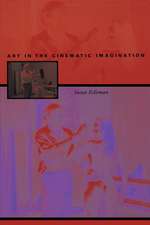Spanish Meta-Art and Contemporary Cinema: Mirrors to the Unconscious
Autor Guillermo Rodríguez-Romagueraen Limba Engleză Hardback – 20 sep 2023
Preț: 538.67 lei
Preț vechi: 773.04 lei
-30% Nou
Puncte Express: 808
Preț estimativ în valută:
103.09€ • 107.23$ • 85.10£
103.09€ • 107.23$ • 85.10£
Carte tipărită la comandă
Livrare economică 12-26 aprilie
Preluare comenzi: 021 569.72.76
Specificații
ISBN-13: 9798765101391
Pagini: 208
Ilustrații: 20 bw illus
Dimensiuni: 152 x 229 mm
Greutate: 0.45 kg
Editura: Bloomsbury Publishing
Colecția Bloomsbury Academic
Locul publicării:New York, United States
Pagini: 208
Ilustrații: 20 bw illus
Dimensiuni: 152 x 229 mm
Greutate: 0.45 kg
Editura: Bloomsbury Publishing
Colecția Bloomsbury Academic
Locul publicării:New York, United States
Caracteristici
Unexpectedly and surprisingly pairs Deleuzian philosophy with Freudian psychoanalysis to reframe and reconstitute one's uncanny relationship to perception, to the visual field, through what is and isn't there
Notă biografică
Guillermo Rodríguez-Romaguera is Assistant Professor of Cinema and Television Arts at California State University-Northridge, USA. He is a narrative filmmaker and film scholar from San Juan, Puerto Rico.
Cuprins
DedicationList of IllustrationsAcknowledgements Introduction: The Veiled Screen 1. The Blinded Spectator: The Defiance of Reconstituted Sight 2. The Conscious Spectator: An Intermedial Contemplation of Las meninas 3. The Spectral Spectator: The Visor Effect in Film 4. The Crystallized Spectator: The Spectator's Double in the Cinematic Abyss 5. The Self-Reflexive Spectator: The Quixotic in Horror 6. The Delusional Spectator: Meta-Film as Virtual Oneiric Simulation Conclusion: The Screen Unveiled Notes Bibliography
Recenzii
Spanish Meta-Art and Contemporary Cinema ambitiously maps cinematic spectatorship through the intermedial cultural histories of Spanish art. Rodríguez-Romaguera's readings richly explore self-reflexive artistic and film traditions through metaphors of veiled vision, trauma, spectrality, or dreaming. This book makes a significant contribution to film aesthetics and a compelling case for revisiting Spanish classic visual art and literature in dialogue with international cinema.
Through the development of concepts such as the veiled screen, Rodriguez provides a fascinating reappraisal of visual theory and a reconsideration of the relationship between art, ideology, and the unconscious. The book's thorough and compelling intermedial analyses of film against works of meta-art demonstrate the possibilities of comparative reading and thinking.
Through the development of concepts such as the veiled screen, Rodriguez provides a fascinating reappraisal of visual theory and a reconsideration of the relationship between art, ideology, and the unconscious. The book's thorough and compelling intermedial analyses of film against works of meta-art demonstrate the possibilities of comparative reading and thinking.




















